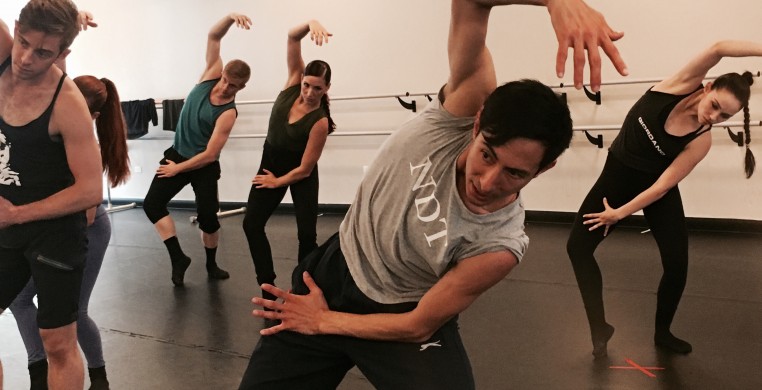Despite a high-stakes cubs game and Halloween parties aplenty, the Harris Theater for Music and Dance was sufficiently filled with excited dance fans for Giordano Dance Chicago’s fall program. In introducing the “iconic, fantastic organization’s” 54th season, Executive Director Michael McStraw reminded us of all the things we could have been doing that night; the gratitude Giordano’s dancers and staff bring to their work is ever-present. The two-night engagement was a glowing example of what Giordano does best: full company, full-out dancing, demonstrated through a new work and favorite revivals, with a couple surprises.
The evening began with Autumn Eckman’s 2015 “Yes, And…,” back after six seasons on the shelf. Including apprentices and members of Giordano II, Eckman’s work for 16 dancers capitalizes on their ability to move with a low center of gravity, weaving in and out of formations, rippling the chest in time with water droplet sounds anchoring Barbatuques’ percussive score. Everyone is naked on top, the men bare chested and women in tan leos with tiny black shorts and black knee socks for a universal look. The title, like the dance, doesn’t give much away in terms of meaning, but a great many ripples and canons aplenty allude to leaders and followers, and perhaps a desire to submit to and play off one another as in the classic improv game of the same name. The quirkiest moments were the ones that resonated most, though sometimes difficult to read on the big Harris Theater stage.
In a rare display of goofiness, “Hi Jinks” appeared next on the program, a four-part fun fest choreographed by Sam Watson in 1998. Cheeky lounge music accompanies the piece’s exaggerated gestures and wacky hip thrusts. Donning white jazz oxfords and big palazzo pants, the dancers drop their palazzos to reveal boxers with smiley faces on the butts, which leads into a series of great costume changes hinting at characters from the 1960s – the “perfect” family, a ridiculous air-biting rhumba, and what felt like a peek into Barbie and Ken’s dream house. In a charged election year that’s been all about “making America great again,” I probably read political overtones into a piece that doesn’t have any, but the sarcastic nod to a perfectly imperfect time period is nonetheless appreciated. Despite "Hi Jinks"’ 1998 vintage, it evades any feel of antiquity.
The same can’t be said of “Cesura,” Jon Lehrer’s R-rated duet from 2000. Unlike any other Lehrer work I’ve seen, sex onstage in tiny leotards isn’t my cup of tea, and when you add in multiple choke holds I lose interest entirely, particularly after the fierce display of girl power in Peter Chu’s highly anticipated world premiere, “Divided Against.”
In the final moments of "Divided," the company’s men, in long, black, tank dresses, writhe on the floor as the women, in pants, move subtly, strongly, slowly backward pulsing to an internal rhythm accentuated by Djeff Houle’s bassy beats. Enormous clapping gestures make no sounds; the dancers sometimes fight against one another, and sometimes against themselves. And sometimes, in the work’s quietest moments, one dancer places a hand on another’s back, cradling, supporting, understanding. “Divided Against” is not pretty, but it’s beautiful. Chu’s liquid movement style is a refreshing departure for Giordano, a company that could easily coast on razzamatazz. Instead, Chu’s psychological thriller pushes the dancers to wipes their faces clean, devoid of the emotions quintessential to this company. It’s a challenge the dancers meet gracefully; without their faces on we witness a level of vulnerability yet unseen.
Ray Mercer’s “Shirt Off My Back” and Kiesha Lalama’s 2011 “Alegria” are a bit overplayed at this point, but the opening solo and duet in Mercer's 2015 hit are still a joy to watch. The upbeat, jazzier section of "Shirt Off My Back" doesn’t pay justice to the piece’s stunning opening, but with plenty of pirouettes and nifty sliding moves on Branimira Ivanova's burnt siena hued button downs, it’s fun nonetheless. Moreover, it felt as though Chu’s work left a residual effect, with the dancers more in their bodies than ever. Even in the biggest and best “wow” moments, there was a calmness - a subtler approach to both pieces that gives them a little space to breathe. Though these works are far from new, it appeared as though the dancers were seeing them with fresh eyes.

